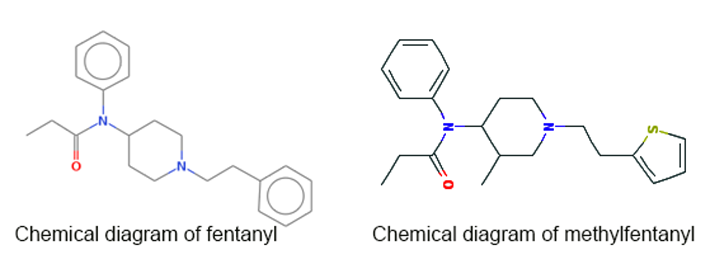Fentanyl, Acetyl Fentanyl, Carfentanil and Now, Furanyl Fentanyl: What’s the Difference?
These four names refer to powerful painkillers of similar chemical composition. Fentanyl is the only one you would ever have received from a doctor and even that is rather unlikely. It’s used only for the most severe pain, such as life-ending cancer pain. Getting just a little too much of this drug can be fatal because of its strength. The other three drugs would never have been given to you by a legitimate medical practitioner. If you were a heroin addict, you might have received one of these drugs from your drug dealer without knowing it.
Fentanyl is usually given to patients in a patch or a slow-dissolving lollipop, both designed to prevent overdose. Carfentanil is a veterinary drug and is used to knock out large animals, like elephants and elk. It is never prescribed for humans. The other two forms are never used medically.
Why All These Forms of Fentanyl?
Drug dealers add these drugs to their heroin supplies to increase their profits because the cheaper synthetic drug increases the potency of the heroin. At first, just Fentanyl was added to heroin supplies. A decade ago, more than 1,000 people died because they thought they bought heroin but what they got was far more powerful. Laws were passed to prevent the importation of Fentanyl from any but specific, authorized pharmaceutical companies.
A few years ago, Chinese companies trying to circumvent those laws came up with a new formula, Acetyl Fentanyl, that was not illegal to ship. Shipments of Acetyl Fentanyl soon began to show up in the U.S. Of course the law caught up with these manufacturers, and Acetyl fentanyl was banned for export from China in early 2016.
And that’s why Furanyl Fentanyl was developed. Chemists involved in the illicit trafficking of drugs know how to shift the configuration of the molecule slightly so that Fentanyl becomes Acetyl Fentanyl or Furanyl Fentanyl. Law enforcement personnel then can’t seize their shipments. This is a cat-and-mouse game that’s been going on for many years, seen also in the manufacture and trafficking of synthetics like bath salts.

Carfentanil is a far more dangerous form of this drug. It’s only used as a sedative for large animals because of it’s phenomenal potency.
In fact, there are many forms of Fentanyl – Methylfentanyl, Butyrfentanyl, Benzylfentanyl and Norfentanyl among them. Only a few are being trafficked to the U.S. and added to the heroin supplies. Others are being purchased by drug users who seek out websites that deal in illicit chemicals and don’t care who they sell to.

Incredibly Powerful
To rate their comparative strengths, opioids (synthetic opiates) and heroin are compared to morphine which is rated a 1 of strength. Methadone is 3 to 4 times as strong, and heroin is typically 4 to 5 times as strong. Fentanyl is 50 to 100 times as strong and Carfentanil is 10,000 to 100,000 times as strong.
Finding these powerful chemicals mixed with heroin has meant death for hundreds of people in the last few years. It only takes two milligrams of fentanyl to kill a person who is not used to consuming opioids. Using heroin is dangerous enough – when heroin supplies have one of these powerful painkillers mixed in, being addicted is far more dangerous than it normally is.
In early 2016, three people in one Oklahoma household lost their lives to heroin that had fentanyl mixed in. The medical examiner for Oklahoma reported that fentanyl killed 47 Oklahomans from the summer of 2015 summer to February 2016. Carfentanil has recently been involved in hundreds of overdoses in New Jersey, West Virginia, Ohio and Kentucky. Because of the antidote naloxone, only a few people have died.
It’s a very dangerous time to be addicted to opioids. To find help for someone you care about, call Narconon Arrowhead today. We can help.


